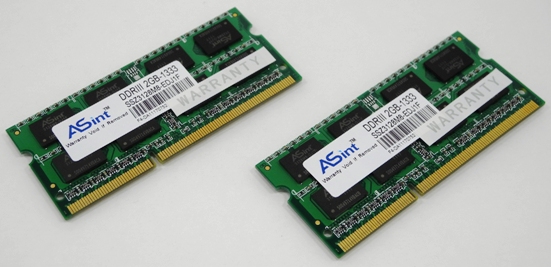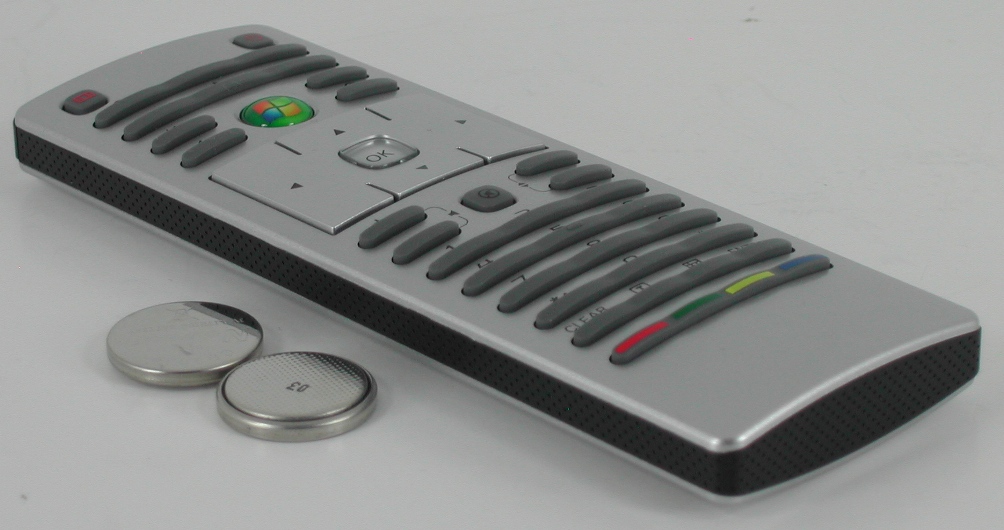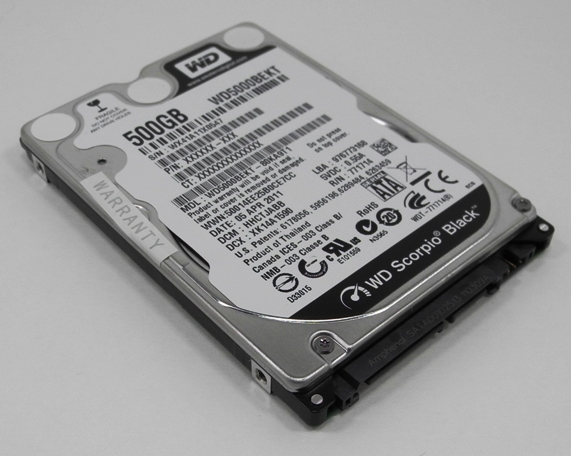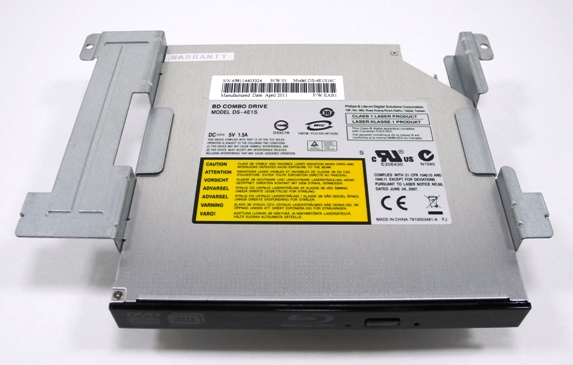ASRock CoreHT 252B Review
by Ganesh T S on September 2, 2011 3:45 AM EST- Posted in
- HTPC
- Intel
- ASRock
- Media Streamer
The ASRock CoreHT 252B is primarily built out of notebook components, and it is not possible for the average enthusiast to build such a system with off-the-shelf components.
Motherboard & Chipset : mini-ITX Intel HM65
The motherboard used in the CoreHT series is based on the Cougar Point Intel HM65 chipset. The CoreHT server series uses the HM67 chipset, and we will take a look at that unit in another review. ASrock's mini-ITX motherboard used in the CoreHT 252B is the HM65-HT. The 2 SATA 6 Gbps ports are available as headers on the motherboard, while one SATA 3 Gbps port is made available as an eSATA3 port. Another SATA port is available as a header on the motherboard (it is connected to the Blu-ray drive).
The mini PCI-E slot is taken up by the Atheros based AzureWave WLAN module. The two sides of the CoreHT chassis are used as antennae. The two DIMM slots are on the right side of the board, next to the CPU.

CPU : Intel Core i5-2520M
The Core i5-2520M is a 35W TDP processor belonging to the 32nm Intel Sandy Bridge family. Clocking in at 2.50 GHz, it is capable of going up to 3.2 GHz for a single core and 3.0 GHz for both the cores in turbo mode. 3MB of Intel Smart Cache is shared between the two cores and the integrated GPU.
GPU : Intel HD Graphics 3000
The integrated GPU in the Sandy Bridge processors come in two varieties, namely, HD Graphics 2000 and HD Graphics 3000. The Core i5-2520M uses the latter. It has a base frequency of 650 MHz, and is capable of going up to 1.3 GHz in stressful conditions.
It supports full 3D video capabilities, QuickSync and WiDi. However, WiDi is not supported by the CoreHT 252B. WiDi makes sense for laptops, but not much for SFF HTPCs. So, we don't fault ASRock for avoiding this feature.
DRAM : ASInt 2 x 2GB DDR3-1333
ASRock has used a relatively new memory vendor in ASInt for the CoreHT 252B. The memory chips operate with a 9-9-9 CAS latency.

Hard Disk : Western Digital Scorpio Black 500GB 7200 rpm 2.5"
The 500GB Scorpio Black is one of the best reviewed hard disks in its class. It has been reviewed to have upto 120 MBps sequential read speeds.
The hard disk is a good choice with respect to the price - performance ratio for the ASRock CoreHT 252B.
Optical Disk Drive : Philips Lite-on Blu-ray / DVD RW Tray Loading Drive
The ASRock CoreHT 252B ships with the Philips Lite-on DS-4E1S BD Combo Drive.
We would have liked a slot loading model, but ASRock reserves that for the high end Vision series. The slot loading model has a considerable cost premium, so we are not really complaining.
MCE Remote
One of the shortcomings of the ASRock HTPCs when compared with something like the Zinos from Dell is the absence of a wireless keyboard / mouse combo. However, ASRock does take care to ensure the presence of an IR receiver in the system and also bundle a MCE remote.
Compared to the MCE remote used in the Core 100, we see a step up. The remote bundled with the unit is the same as the one bundled with the Vision 3D.
Unfortunately, the quality of the MCE remote is a big letdown. The keys are quite small and the unit feels cheap in the hand despite being pretty decent in appearance.

In the next few sections, we will take a look at the performance of the ASRock CoreHT 252B.












54 Comments
View All Comments
DocJones - Friday, September 2, 2011 - link
I've been wanting to put together a media server with an i5 CPU just about down this line. I currently run Mezzmo as the server software since it does a pretty good job at transcribing video on the fly based on what device is requesting it.I wonder if this has enough juice to transcribe 1080p and send it over the wire to our media players, and if so... can it do more than one?
ganeshts - Friday, September 2, 2011 - link
For a server type situation, I would recommend a desktop chipset.However, the i5-2520M is very very capable.. Maybe you should ask Mezzmo whether they can take advantage of QuickSync?
DocJones - Friday, September 2, 2011 - link
i5 2405S better?http://ark.intel.com/products/55446/...he-2_50-GHz...
Something this form factor would be nice if it worked. Mezzmo folks pretty much say I need a true 4 core 8 thread CPU to perform transcoding on the fly. I find that hard to believe. Others have noted that a Intel Core 2 Quad Q8400 LGA775 'Yorkfield' 2.66GHz 4MB-cache while hot handles the job just fine.
They use ffmpeg so I don't think they support QuickSync right now.
ganeshts - Friday, September 2, 2011 - link
Being paid software, I think Mezzmo needs to pull up its socks and adopt QuickSync for its transcoding operations. I think they can afford to sign whatever NDAs are required for this purpose (Actually, I don't think they need any because Andrew Van Til (www.babgvant.com) has actually implemented QuickSync support in his DVRMSToolBox program).Please hound them about this. I am also personally interested in finding out whether QuickSync is flexible enough for media server software to take advantage of.
blckgrffn - Friday, September 2, 2011 - link
I would hope that this guy starts under $500, but seeing the prices on the Core HT100 at greater than $700, my enthusiasm is tempered a bit.icrf - Friday, September 2, 2011 - link
Agreed, for $500, I'd buy one.Since this is mostly laptop parts, what does a similarly spec'd laptop cost? No keyboard, touchpad, or screen saves some costs. What does this add that a laptop doesn't? A token remote control?
ganeshts - Friday, September 2, 2011 - link
Remote control + IR receiver and form factor combined with scale of manufacturing mean that the cost almost works out to be the same as that of a laptop.For many, a laptop can double up as a HTPC (even I used my notebook as a HTPC between 2005 and 2007), but PCs like these cater to those who need a quiet unobtrusive unit as part of the living room cabinet. Plus, this is a desktop replacement, i.e, you can schedule recordings with an external TV tuner when you are away from the home (or any other such usage scenario).
In the end, it is about horses for courses :)
cknobman - Friday, September 2, 2011 - link
ZBOX nano AD10cjs150 - Friday, September 2, 2011 - link
Initial reviews look very promising although probably best to get the bare bones version and kit out with own memory and an SSD.When available I am going to get one and play with it to see how well it works
icrf - Friday, September 2, 2011 - link
Agreed. It's likely less than half the price, and I can do without an optical drive. I plan to run Windows, so the Linux driver situation around AMD's video decoding hardware don't apply, either (assuming that hasn't been straightened out since I last read about it).Still, it is nice to have all that extra CPU power available for whatever the future brings. I'm just not sure it's going to be worth the several hundred dollars more they're likely going to be asking for it.
In any case, I'd still love to see a review here on the unit, comparing it to this one as a budget alternative. I am a big XBMC proponent (and Hulu Desktop), so I really liked seeing the detailed focus on it, something I'd like to see carried forward in future HTPC reviews.